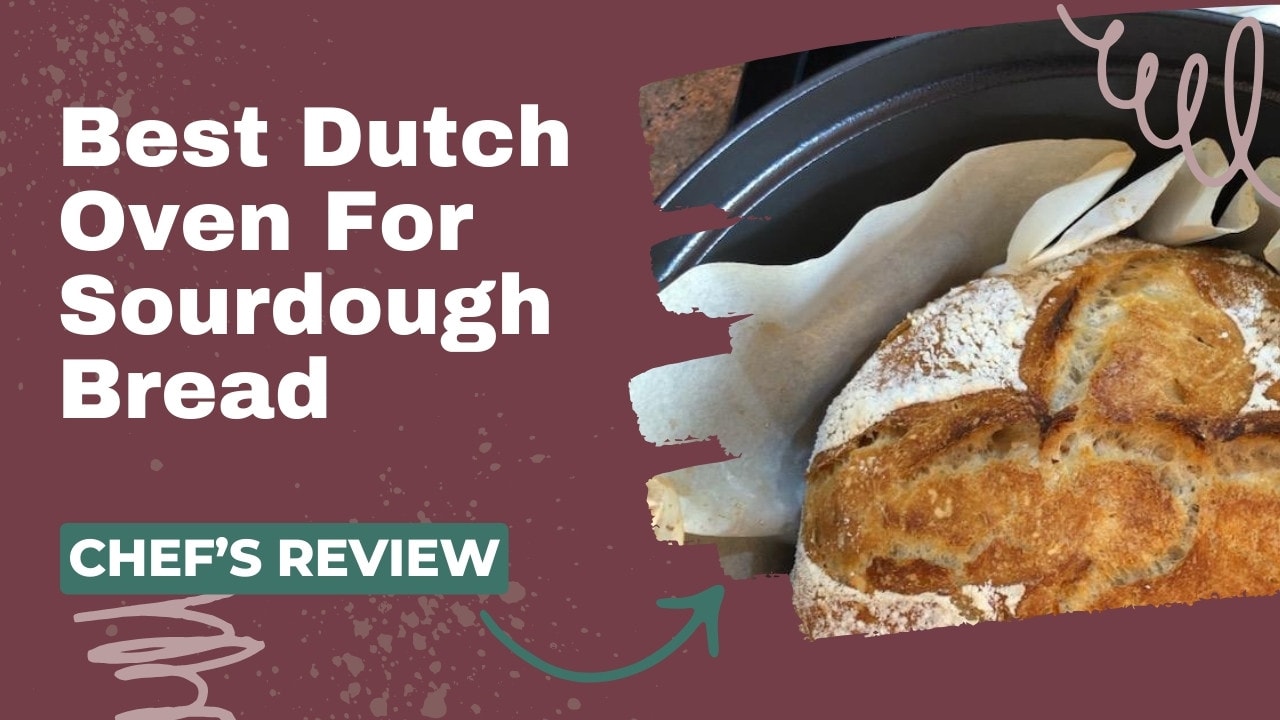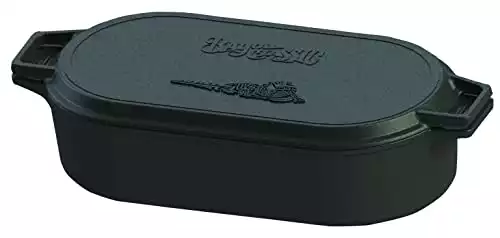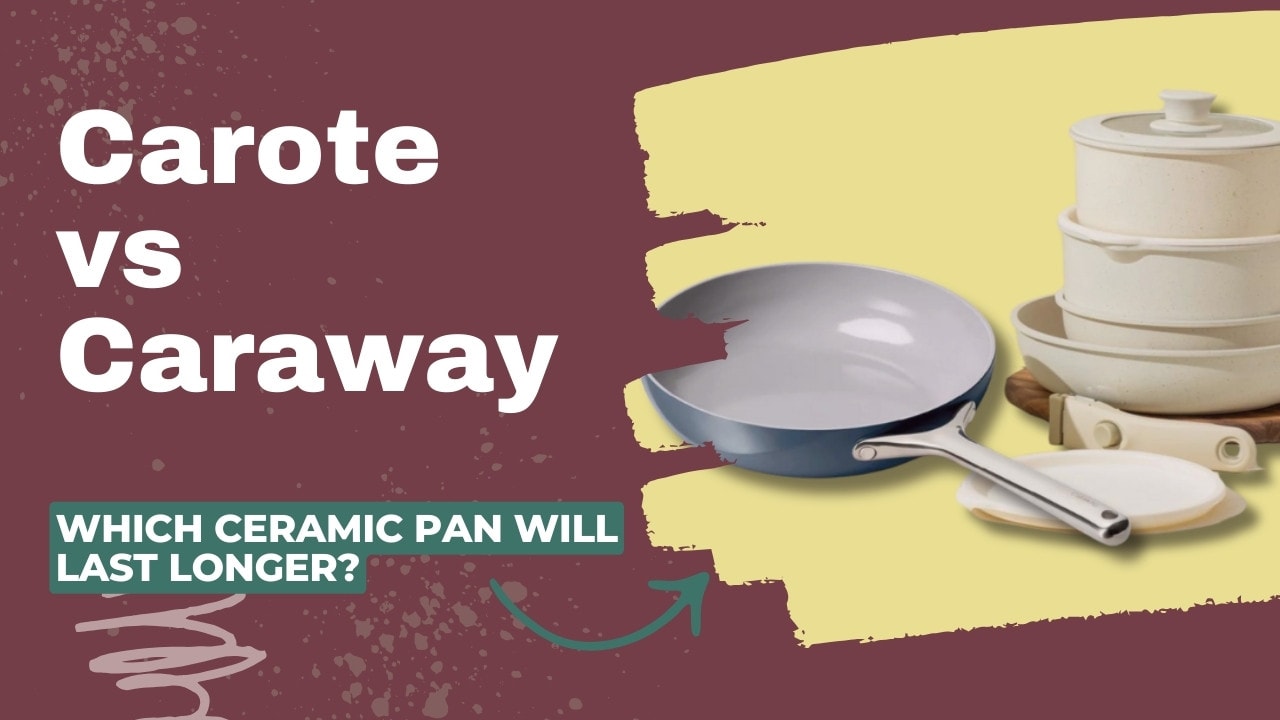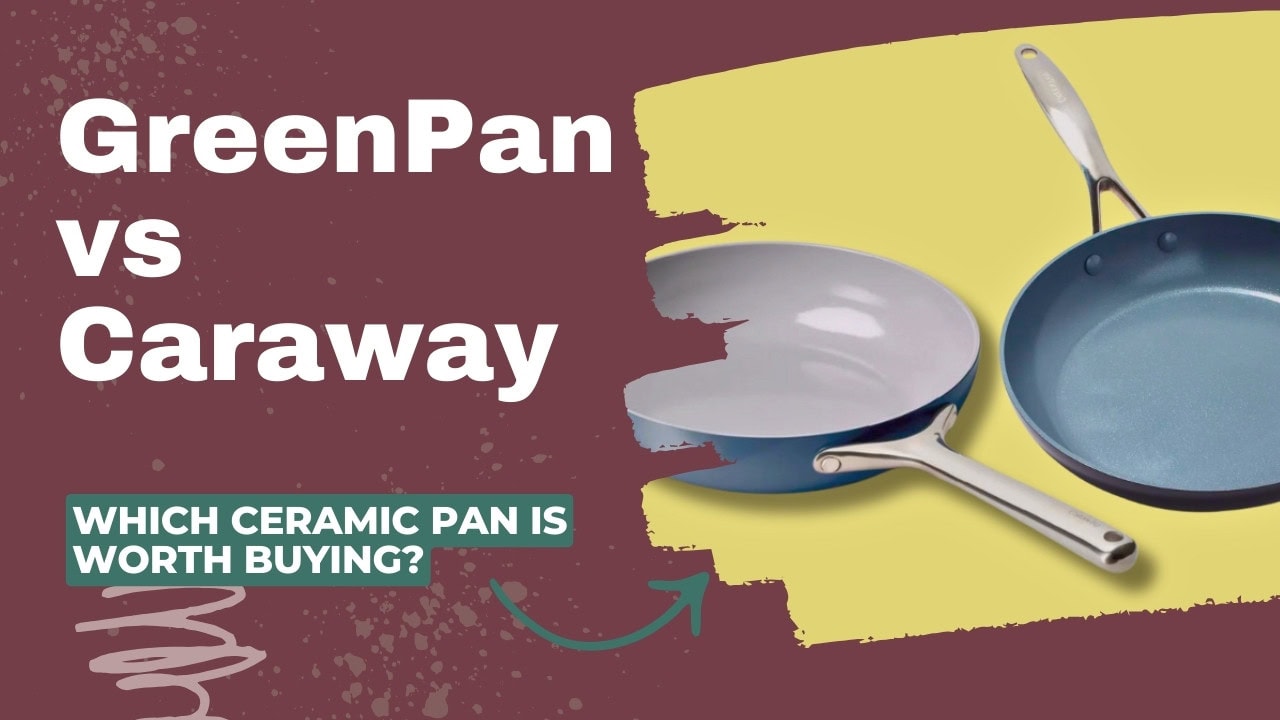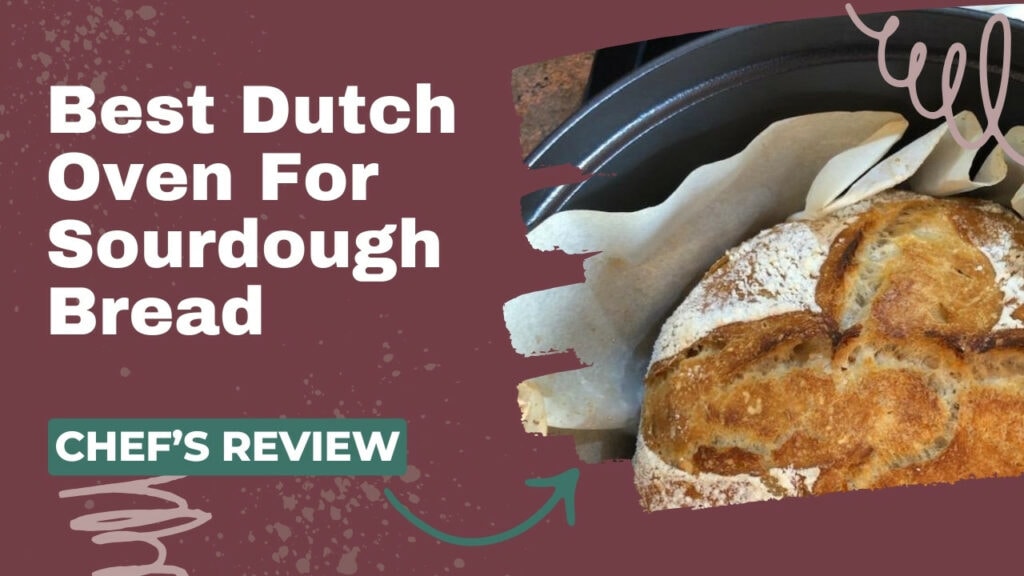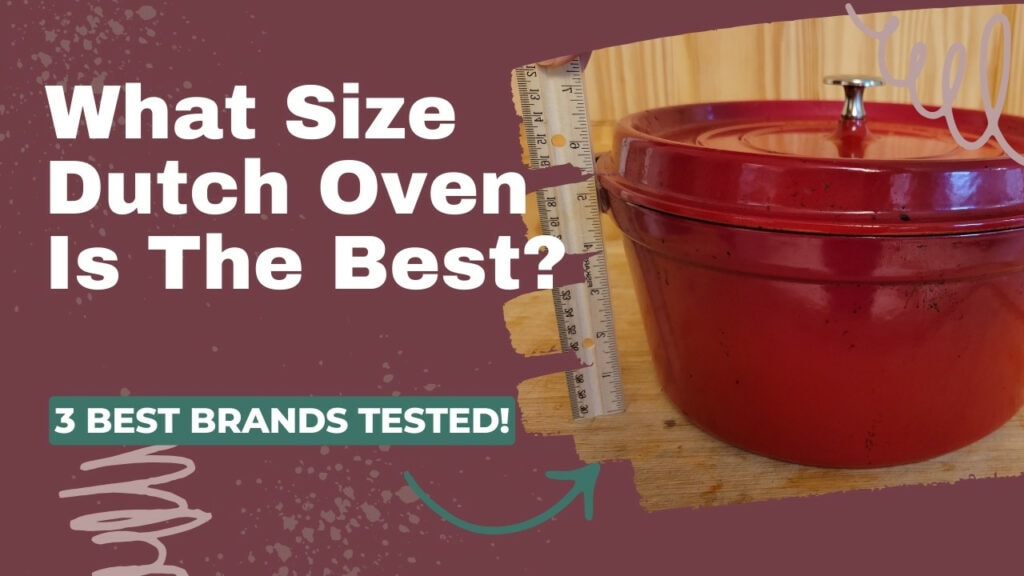Making sourdough is a labor of love. You spend many hours feeding your starter, developing gluten, and proving the loaf – and it would be a colossal disappointment to fail at the final hurdle and come out with an underwhelming bake. That’s where Dutch ovens come in to save the day!
If you’re a budding sourdough enthusiast, I’m sure you’ve heard about baking sourdough in a Dutch oven. As a pastry chef specializing in bread, I can firmly say that it is worth all the hype!
In this article, I’m going to recommend my six favorite Dutch ovens that are perfect for baking sourdough bread. I’ll also supply a quick buyer’s guide so you know what to consider when picking one out.
What Makes a Dutch Oven Good for Baking Bread?
Alright, before we delve into some product recommendations, I want to break down what makes a Dutch oven suitable for baking bread.
What’s The Best Dutch Oven Size for Sourdough Bread?

The ideal Dutch oven size for sourdough bread is 4.5 to 6 quarts. This size range accommodates the expansion of the loaf during baking, giving enough room for growth without restricting the bread’s shape.
It’s important to match the Dutch oven size with your proving basket to guarantee a good fit. A properly sized Dutch oven helps achieve the desired oven spring and crust development, crucial for a perfect sourdough loaf.
The Challenger Bread Pan – Best Dutch Oven for Baking Sourdough Bread
 The Challenger Bread Pan | Challenger Breadware
The Challenger Bread Pan | Challenger Breadware
Out of all the Dutch ovens made specifically for bread, The Challenger Bread Pan is one of the best out there.
The trademarked pan has a flat base with a tall domed lid. This means you can use the flip method to transfer the loaf to the Dutch oven, which will deflate the dough as little as possible. This will give you nice, big air bubbles in your final loaf.
The lid is nice and heavy and sits very firm on the base, creating the perfect seal for trapping in the steam. All these little details show that this pan was designed with sourdough bread in mind.
Quick Overview:
Pros
Cons
Lodge Cast Iron Dutch Oven – Best Affordable Dutch Oven for Sourdough Bread
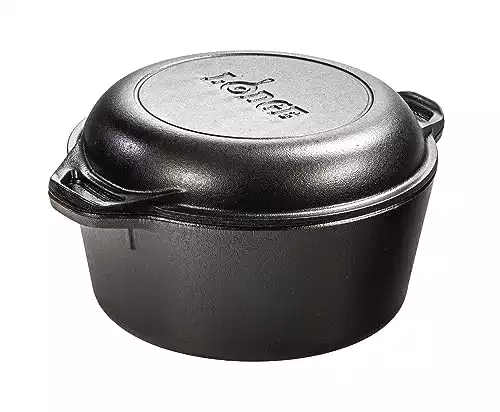 Lodge Cast Iron Dutch Oven
Lodge Cast Iron Dutch Oven
The Lodge Cast Iron Dutch Oven is a crowd favorite I have recommended for many uses, including baking sourdough.
Traditionally, the Dutch oven is used with the lid on top and the deep base below. But this Dutch oven has a flat lid that doubles as a 10.25” skillet. I use this to my advantage to bake sourdough. I flip the dough out of the proving basket into the lid and place the base on top.
The tall sides provide the perfect amount of room for your sourdough to prove upwards. Then, I place the Dutch oven into the oven upside down to bake.
Quick Overview:
Pros
Cons
Le Creuset Signature Enameled Cast Iron Dutch Oven- Best for Boules
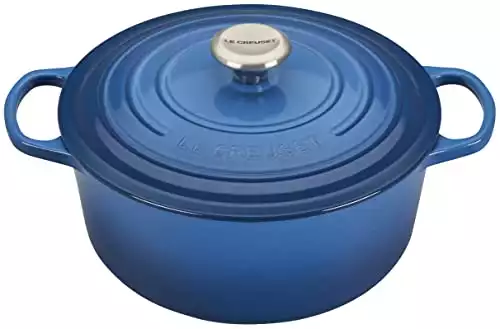 Le Creuset Signature Enameled Cast Iron Dutch Oven
Le Creuset Signature Enameled Cast Iron Dutch Oven
The Le Creuset Round Enameled Cast Iron Dutch Oven is the pan you need when you want a versatile piece that is also perfect for baking bread. The Le Creuset specially designed bread pans are very appealing, but if you want to use the pot for other dishes as well, then the classic Dutch oven is what you need.
This enamel is oven-safe up to 500 F, so it’s perfectly safe for baking your sourdough nice and hot at 450 F. The one detracting factor is that it’s quite deep. This means you will need to create a parchment paper sling, proof the shaped dough on it, and then gently lower it into the base of the pot. Be very careful when doing this so you don’t knock out any air.
Quick Overview:
Pros
Cons
Staub Enameled Cast Iron Round Cocotte
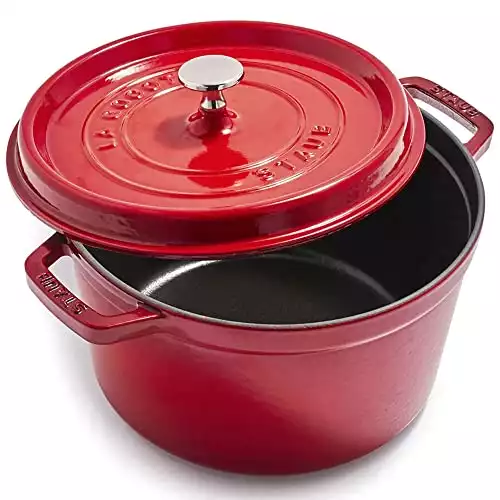 Staub Enameled Cast Iron Round Cocotte
Staub Enameled Cast Iron Round Cocotte
The Staub Enameled Cast Iron Round Cocotte proves that Le Creuset is not the only fantastic enameled cast iron option. Staub makes high-quality porcelain enamel that can tolerate up to 500°F in the oven, perfect for sourdough!
Like the Le Creuset, you will need to use the parchment sling trick to transfer your loaf into the Dutch oven. Do this very gently and only score the loaf once it’s safely in place. Then, place it on the self-basting lid, which is designed to return moisture back to your loaf.
Quick Overview:
Pros
Cons
Bayou Classic Cast Iron Oval Fryer- Best Dutch Oven for Batards
Unlike many bread pans, this option is multi-use, with the lid converting into a griddle pan. So you get a lot of bang for your buck with this purchase.
Quick Overview:
Pros
Cons
Cuisiland Cast Iron Bread and Loaf Pan – Best for Baking Sourdough Bread
 Cuisiland Cast Iron Bread and Loaf Pan
Cuisiland Cast Iron Bread and Loaf Pan
I wanted to include this Cuisiland Cast Iron Bread and Loaf Pan because it's a good cast iron option and a dupe of The Challenger Pan I mentioned up top. It's very similar in shape and size, but there is one significant deterrent.
Some customers have complained that their lids arrived wobbly, which defeats the object of using a Dutch oven to trap the steam.
Saying that, my favorite feature of this Dutch oven is the flared handles. They are large and flared away from each other. This makes it easy to reach in and lift the lid off for the final 20 minutes of browning without removing the Dutch oven from the oven.
Quick Overview:
Pros
Cons
Buying Guide
I know by the time you found this article, you were probably sold on Dutch ovens as bread bakers, but I wanted to go into a bit of detail as to why they are so well suited to this task.
Sourdough relies heavily on oven spring to produce an open, aerated crumb texture. So, it’s vital that the bread has time to rise up before the crust develops. That’s why professional bread ovens have steam injectors to delay the crusting process and allow the bread to rise to its full potential. This method also results in a beautiful tall loaf with a crispy crust.
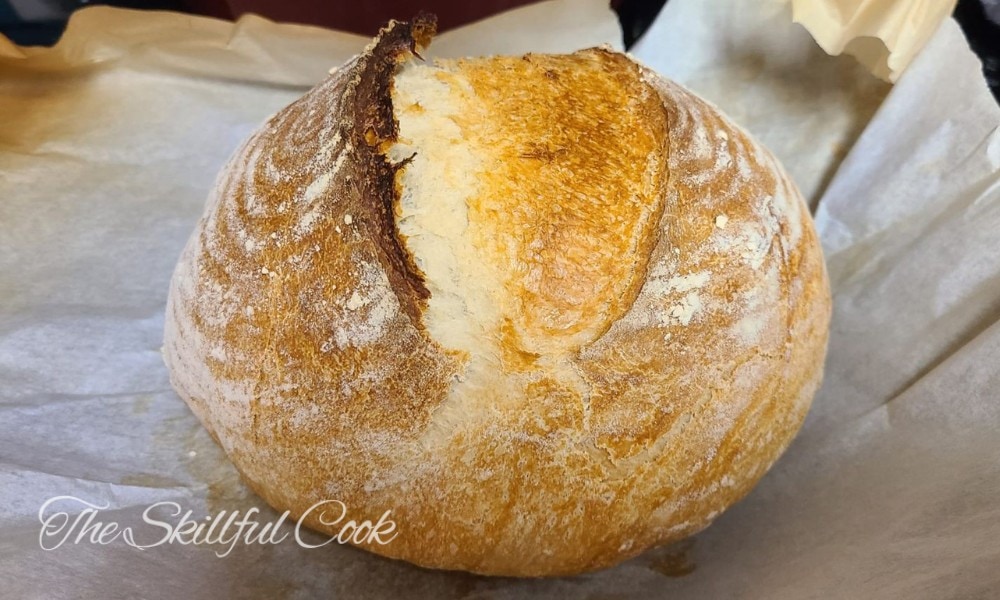
The best way to mimic the even heat and steam content of a professional oven is with a Dutch oven. The lid needs to seal tightly to trap the steam and create a controlled environment of even heat. After the oven spring has finished (approximately 20 minutes of baking), you can remove the lid to allow the loaf to brown and crisp up.
Best Materials For Dutch Ovens
There are many options for Dutch oven materials out there like stainless steel, aluminum, ceramic, enameled cast iron, and natural cast iron. But for baking sourdough, I always choose enameled cast iron or natural cast iron. Let’s get into why.
Enameled Cast Iron vs. Natural Cast Iron
Since enameled cast iron is simply natural cast iron in enameled clothes, they have very similar properties that make them ideal for bread baking. They have great heat retention, creating even contained heat when the lid is placed on. This creates the perfect controlled environment for a sourdough loaf to thrive. Since they both work well for bread, is there any reason to choose enameled iron over regular cast iron?
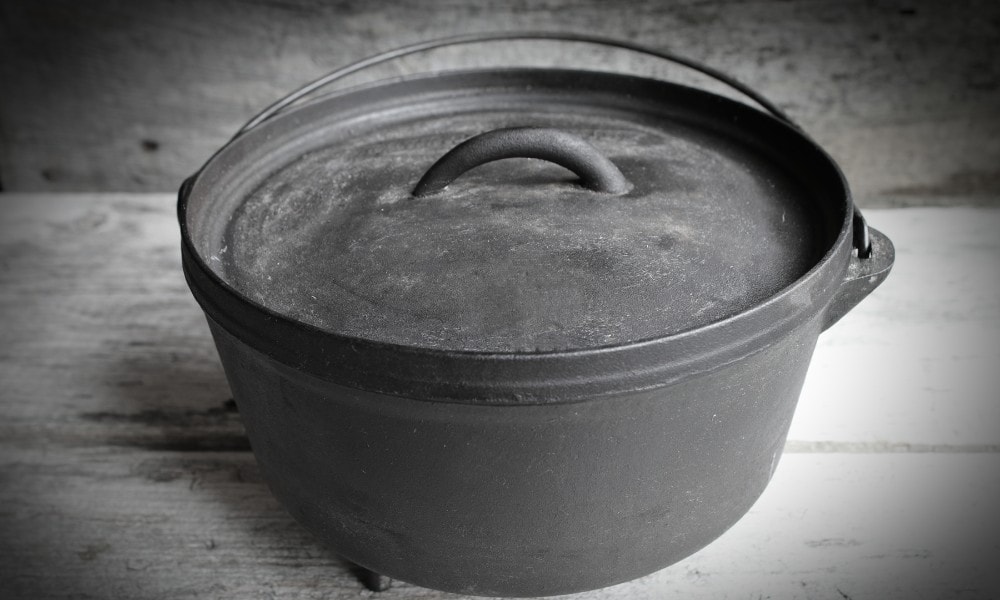
Natural cast iron is very popular because it’s very affordable and will last you years. It can handle oven temperatures up to 800°F, so it’s ideal for the high heat required for baking sourdough. One downside is that it needs to be seasoned inside and out to maintain its nonstick surface to stop your loaf from getting stuck. The exterior of the pot can leave dark grease stains anywhere you set your oven down.
Enamel cast iron, on the other hand, doesn’t need any maintenance as the shiny, porcelain enamel finish is semi-nonstick. It’s much easier to clean, and the exterior of the pot stays residue-free. However, the max oven temperature for some enamel cast iron Dutch ovens is 400°F. Sometimes this maximum temperature is due to the handle material (Le Creuset had plastic handles until very recently) and sometimes it’s due to the heat tolerance of the enamel itself.
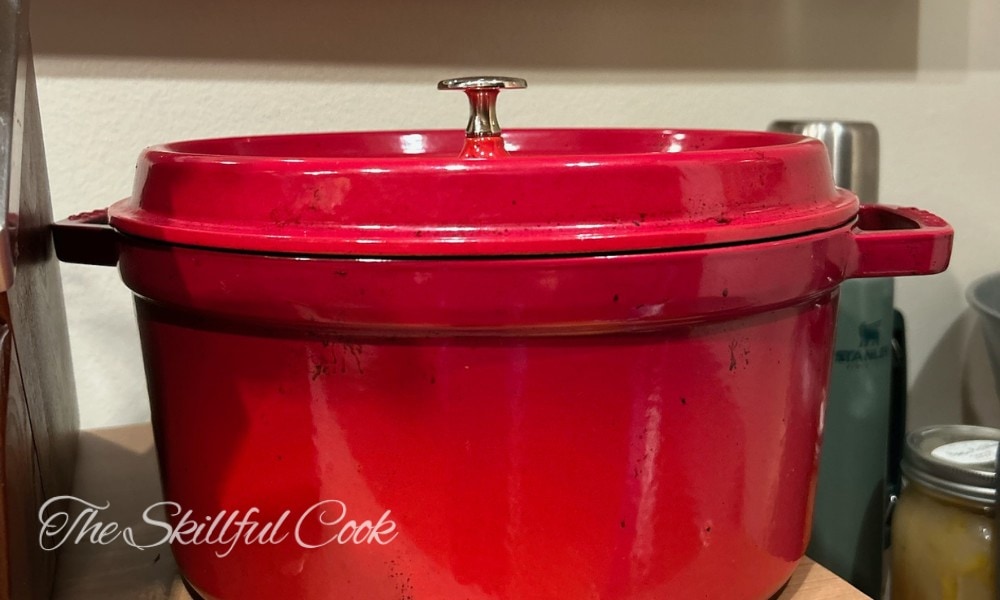
Sourdough is generally baked between 400-450°F, so look for a Dutch oven that can withstand 500°F temps. (Modern Lodge and Staub ovens both work, but be wary of ones you get second-hand.)
Is Iron Better Than Other Materials Like Ceramic?
In many ways, ceramic and iron are very similar. They have excellent heat retention and are heavy enough for the lids to seal efficiently. This means that ceramic or stoneware is a good material for baking bread; there are even special bread bakers available from brands like Emile Henry.

The main reasons I would choose iron over ceramic are durability and price. Ceramics are easy to chip or crack if they are mishandled, even if they are high quality. They are also more susceptible to thermal shock, so you have to be very careful when removing them from the oven. High-quality ceramics are also very expensive, especially when compared with the very affordable raw cast iron.
What Size and Shape Dutch Oven is Best For Sourdough?
The shape of the Dutch oven you need depends on which types of loaves you like to make. If you like making boules or round loaves, you need a round Dutch oven. But if you regularly make batards or long loaves, then an oval Dutch oven will suit you better.
The Challenger Pan and the Cuisiland Cast Iron Bread and Loaf Pan are more oblong in shape and are appropriate for batards and small boules. Regardless of shape, the sides of the Dutch oven need to be tall so the bread rises up and not out.
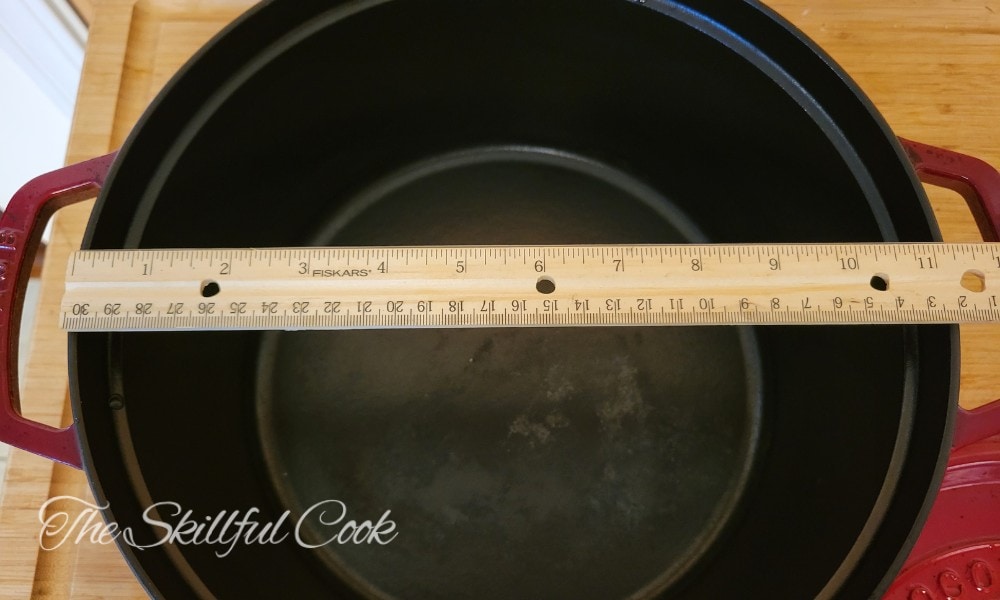
Once you’ve picked the shape, you need to consider size. I recommend buying your Dutch oven to match the size of your proving basket or vice versa so you know your loaf will fit. The loaf is going to grow a lot when it goes through oven spring, so you need to take that into account and buy a Dutch oven 4x times the volume of the loaf. For example, if you use 1kg of flour to make the dough, you need a Dutch oven that is 4 qt.

Funnily enough, using a Dutch oven that is too big or too small will have a similar restriction on the loaf’s growth. The small Dutch oven will not provide enough room for the loaf to grow. But a Dutch oven that is too big will also limit the growth because the steam will sit up near the lid. This will limit the contact with the dough and allow the crust to form too early. Both issues will result in a loaf with a tight crumb and unpleasant texture.
Best Brands For Dutch Ovens
The first brand that usually comes up when you look for Dutch ovens is the coveted Le Creuset. But is Le Creuset really better than other brands? In some ways, yes.
When it comes to enameled cast iron, Le Creuset and Staub are my go-to brands. They are completely compliant with safety regulations, and they are very high quality. But with natural cast iron, you can be a lot less strict and buy from any brand, because there are no coatings added that could leach chemicals into your food.
✅ No seasoning required
✅ Beautiful color range
✅ Knob safe at 500°F
✅ Best for Boules
You can buy very affordable cast iron Dutch ovens; you could even thrift one. After you strip and reseason it, it will be safe to use and most likely last a lifetime.
Conclusion
Overall, you’ll get the best results from your sourdough if you use cast iron Dutch ovens – whether enameled or uncoated. I recommend the specially designed Challenger Bread Pan as the best overall product, but the Lodge Cast Iron Dutch Oven is also an excellent, affordable choice.
What’s your favorite Dutch oven for sourdough? Leave your answer and any questions you might have down below. I love baking bread and can’t wait to chat with you about it!

